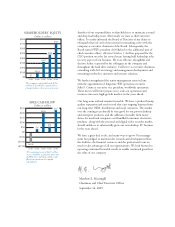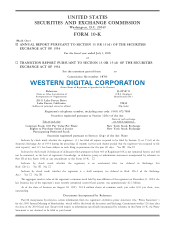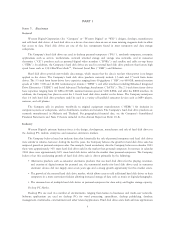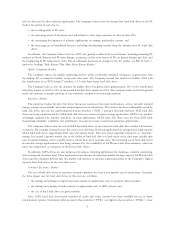Western Digital 2005 Annual Report Download - page 14
Download and view the complete annual report
Please find page 14 of the 2005 Western Digital annual report below. You can navigate through the pages in the report by either clicking on the pages listed below, or by using the keyword search tool below to find specific information within the annual report.exposure to changes in demand, facilitates inventory management and allows the Company to achieve lower costs through
economies of scale purchasing. This platform strategy also enables computer manufacturer customers to leverage their
qualification efforts onto successive product models. The Company expects to continue to utilize this platform strategy as
it continues to develop products for the mobile market and the emerging markets for hard disk drives specifically
designed for handheld applications, such as digital music players and audio-video applications, such as digital video
recording devices.
In addition to the development of the overall hard disk drive, WD also spends considerable effort and expense in
the development of WD head technology used in the majority of its hard disk drive products. In general, the design and
manufacturing of WD heads consists of engineering and fabricating a read element for reading data from a disk, a write
element for writing data to a disk, and slider. The slider functions similar to an airplane wing and allows the read and
write elements to fly over the surface of the disk drive and to land, on either the disk substrate or a special ramp, when
power is not applied to the hard disk drive.
For an additional discussion of technological innovations, see Part II, Item 7, under the heading ""Risk Factors That
May Affect Future Results.''
Sales and Distribution
The Company sells its products globally to Original Equipment Manufacturers, or ""OEMs,'' distributors and
retailers. OEMs purchase the Company's hard disk drives and assemble them into the computer or other consumer
electronic systems they build. Distributors typically sell the Company's hard disk drives to small computer manufacturers,
dealers, systems integrators and other resellers. Retailers typically sell the Company's hard disk drive products directly to
end-users.
Original Equipment Manufacturers. Sales to OEMs accounted for 58%, 51% and 52% of the Company's revenue in
2005, 2004 and 2003, respectively. During 2005, the Company's major OEM customers included Dell and Hewlett-
Packard. During 2005 and 2004, sales to Dell accounted for 16% and 14%, respectively of the Company's revenue.
During 2003, sales to Dell and Hewlett-Packard accounted for 20% and 13% of revenue, respectively. The Company
believes that its success depends on its ability to maintain and improve its strong relationships with the leading OEMs.
OEMs evaluate and select their hard disk drive suppliers based on a number of factors, including overall quality and
reliability, storage capacities, performance characteristics, price, service and support, ease of doing business, and the
supplier's long-term financial stability. They typically seek to qualify two or more providers for each generation of hard
disk drives, and once an OEM has chosen its qualified hard disk drive vendors for a given product, it generally will
purchase hard disk drives from those vendors for the life of that product. To achieve success with OEMs qualifications, a
hard disk drive supplier must consistently offer hard disk drives featuring leading technology, quality, reliability and
acceptable capacity per disk. Suppliers must quickly achieve volume production of each new generation of high quality
and reliable hard disk drives. To quickly achieve high volume production, a hard disk drive supplier must have access to
flexible, high-capacity, high-quality manufacturing capabilities.
Many of the Company's OEM customers utilize just-in-time inventory management processes or supply chain
business models that combine ""build-to-order'' (in which the OEM does not build until there is a firm order) and
""contract manufacturing'' (in which the OEM contracts assembly work to a contract manufacturer who purchases
components and assembles the computer based on the OEM's instructions). For certain OEMs, the Company maintains a
base stock of finished goods inventory in facilities located near or adjacent to the OEM's operations.
For an additional discussion of the need to adapt to customers' business models and maintain customer satisfaction,
refer to Part II, Item 7, under the heading ""Risk Factors That May Affect Future Results.''
Distributors. The Company uses a select group of distributors to sell its products to small computer manufacturers,
resellers, dealers and systems integrators. Distributors accounted for approximately 36%, 42% and 40% of the Company's
revenue for 2005, 2004 and 2003, respectively. Distributors generally enter into non-exclusive agreements for specific
territories with the Company for purchase and redistribution of product. The Company grants its distributors limited
price protection rights.
8
























